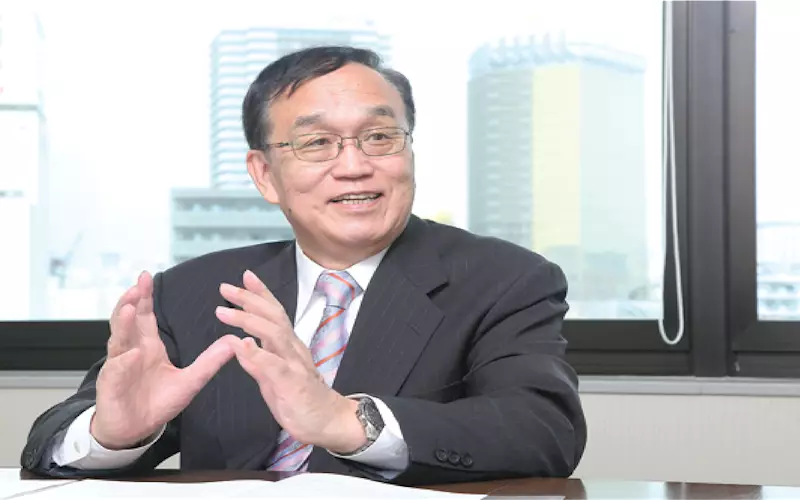Satoshi Mochida: We will see more robots on the shop floor
Komori CEO and president Satoshi Mochida in conversation with PrintWeek
08 Feb 2022 | By PrintWeek Team
PrintWeek (PW): Tough 18 months...
Satoshi Mochida (SM): Even after the effects of Covid-19 have subsided, I believe that we will never completely return to previous conditions. We need to fundamentally change the way we do things.
PW: Your learnings from 2021...
SM: First, I believe that the labour force that has been drained in the pandemic will never return to the pre-Covid-19 situation, and that labour shortages and labour cost problems will worsen. Therefore, it is essential to promote automation and digitalisation to improve productivity.Second, supply chains affected by changing conditions will also not return to their previous state, but will need to be transformed into flexible and balanced manufacturing systems to deal with material procurement and cost fluctuations.Third, environmental issues are becoming more of a concern, significantly impacting corporate activities, social behavior, and price increases.
PW: How has your company and factory sites responded to the challenges of the Covid era?
SM: We have been promoting two types of digitalisation: digitalisation of marketing activities and digitalisation of customers’ printing plants.
PW: Anything on the ideas front? Any new research or innovation?
SM: In the digitalisation of marketing activities, amid the cancelling of many real events globally and the shift to new event modes such as online (virtual) and hybrid events, including Drupa, we have been strengthening communication of the latest information to meet customer needs through online webinar shows and remote business meetings along with video streaming. In the digitalisation of printing plants, we offer KP-Connect Pro, middleware that realises digital transformation (DX) through process streamlining and visualisation. KP-Connect Pro is being introduced by printing companies around the world. As for ideas, we offer Smart Color as a way to change the supply chain in the printing industry amid the growing interest in SDGs and the environment.
PW: How does it help, and in which segment?
SM: In the packaging industry, the problem of waste loss in the supply chain is becoming more evident because costs cannot be met without long runs. In addition, in-person attendance at printing is sometimes impossible due to Covid-19. For these conditions, Smart Color (Komori product name) technology, which reproduces high-colour-gamut special colours using seven colours [CMYK plus O (orange), G (green), and V (violet)] or six colours (adding O and G), eliminates the need for colour changeover and roller cleaning, enabling short-run production and ultimately reducing waste loss. Due to digital numeric control of colour, there is no need for attendance at printing. This way Komori is proactively providing solutions to the challenges of the packaging industry.
PW: The pandemic has impacted India’s prospects to become a USD5 trillion economy by FY25…
SM: The Indian market is recovering.Although total orders for offset presses have declined compared to the pre-pandemic period, orders for package presses have been remarkable, and the price per offset press has risen substantially due to the shift to multi-colour and labour-saving printing.
PW: Has the last quarter numbers reposed faith in the Indian market?
SM: We have received a large number of orders from the packaging segment alone, indeed the highest in our sales history for packaging machines in India. In the Indian market, we have captured more than 50% of the market share.
PW: Brands (FMCG and non-FMCG) are seeking more and more from print and packaging…
SM: Increasing productivity, eliminating waste, and improving profits while at the same time achieving decarbonisation for the environment will lead to strengthened competitiveness. In particular, the packaging industry needs to focus on three areas to improve productivity: the printing process, the entire printing plant, and change of the printing industry supply chain.

PW: As a global manufacturing brand, how can our industry cater to the new normal of - gaining speed; more flexibility; profit-centric approach; and lower carbon footprint?
SM: In the printing process, the demand for short-run production and immediate delivery is becoming greater, and printing presses with high ROI are needed. Increasing printing speed, shortening makeready time, and reducing waste sheets are the key points. Another way to increase the productivity of the entire printing process is to downsize by consolidating with the latest high-efficiency printing presses.
PW: Meaning?
SM: For example, by consolidating three older, less productive presses into two of the latest, more productive presses, you can greatly reduce waste paper and power consumption while ensuring higher productivity than before, resulting in higher profits and a significant reduction in CO2 emissions. Komori is rolling out the Lithrone GX/G advance series of presses and is working to improve productivity in the printing process.
PW: In the printing plant optimising the entire process is key…
SM: There are many processes at the printing site, and with analogue process management such as job tickets, it is difficult to coordinate with prior and later processes and respond to changes, so there are limits to raising overall productivity. However, when each process is connected through digitalisation, the entire process can be visualised and optimised. Since it’s possible to grasp real-time operation information, it’s possible to identify where bottlenecks are and take immediate action. This not only prevents losses, but also lead to increased profits. If the productivity of the entire printing plant is improved, energy efficiency will increase, which will ultimately reduce CO2 emissions and contribute to a decarbonised society.
PW: How should print adopt marketing strategies that promote the print brand beyond the function of product or service? One school of thought is, the key is to do more than just meet consumers’ immediate needs. What is your view?
SM: There are many products that have a high impact on the environment, such as plastic bottles, but I think it will be necessary to clearly communicate the SDGs to consumers by making paper containers and other products that take into account recyclability and environmental impact.
PW: 77% of Indian consumers are actively engaging with sustainability. These consumers will invest time and money in companies that try to do good. Three sustainable actions you have undertaken in the past year that you can share with us?
SM: One, we have built a successful case-study of a significant reduction in the number of paper slips and the streamlining and visualisation of the workflow by promoting KP-Connect Pro, middleware for realizing printing DX. Two, we followed initial users of the advance model of sheetfed offset presses to confirm real productivity improvement. In general, productivity has improved by 30% to 35% compared to conventional machines. And last, we developed Smart Colortechnology to revolutionise paper loss reduction, ink stock reduction, and losses happening at colour changing. We conducted demonstration field tests at users’ sites.
PW: Is there a Green Gap between what our industry talks about; and the rest of society? For example, the industry uses terms such as “biodegradable” and “circular economy”. How can we bridge the knowledge gap?
SM: In Japan, awareness of sustainability transformation (SX) has recently become a major topic. This indicates that in an environment of greater uncertainty, companies are increasingly emphasising sustainability and balancing corporate earning power with environmental, social and governance (ESG) factors.
PW: Any lessons you can share from a customer that have been resilient or innovative (and flourished) during the past 18 months?
SM: Some companies have re-examined the nature of printed materials that along with electronic media are a means of conveying information and products reliably. These firms have achieved results by focusing on advanced direct mail and home delivery products. During the Covid-19 pandemic, a printing company improved productivity by promoting multi-tasking through employee training while keeping employee attendance down for the satisfaction of employees and their families. Another printing company improved productivity, working hours, and labour saving by actively investing in double-sided, one-pass presses.
PW: Your plans for 2022?
SM: In the printing industry, too, we believe that efforts to reduce environmental impact are essential. We plan to propose to customers the combination of the new Lithrone GX/G advance series lineup and KP-Connect Pro, which realises DX throughout the entire production process, for converting printing plants into smart factories and thereby realising high productivity and further reduction of the environmental impact. At the same time, we consider the Indian market to be an important market for us, and we plan to continue developing and offering products that meet the needs of this market. We hope to steadily implement the company’s management philosophy of – customer kando or satisfaction.
PW: One outrageous prediction for the year to come …
SM: It may not be a novel direction, but I think we will see more robots being deployed in print production sites to solve the labour shortage.n
Quick fire questions
- How do you unwind?
Walks and reading.
- One piece of music you love?
Everything by Chopin and Kei Ogura.
- Favorite film?
Mainly action movies. More action is better.
- Three books by your bedside?
Books on history and on Zen teachings as well as Analects of Confucius.
- One thing about print you always utter in a public forum?
Printed electronics technology and the way it will develop.
- One tech-guru you want to meet - and why?
Would have loved to meet Gutenberg and know the viewpoint and background of what led to a major historic printing invention.












 See All
See All